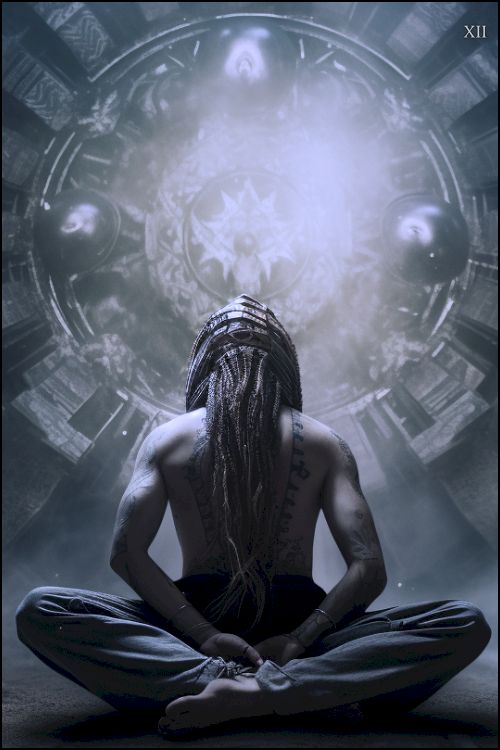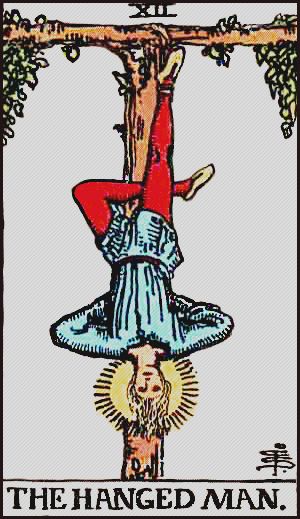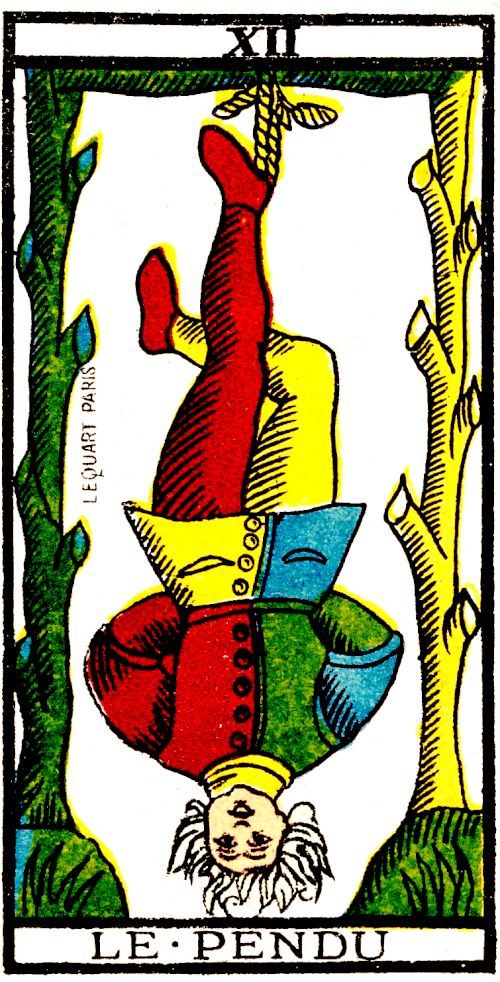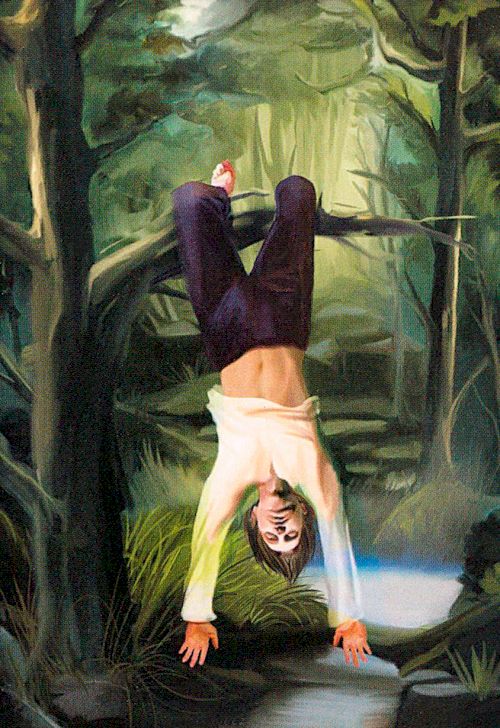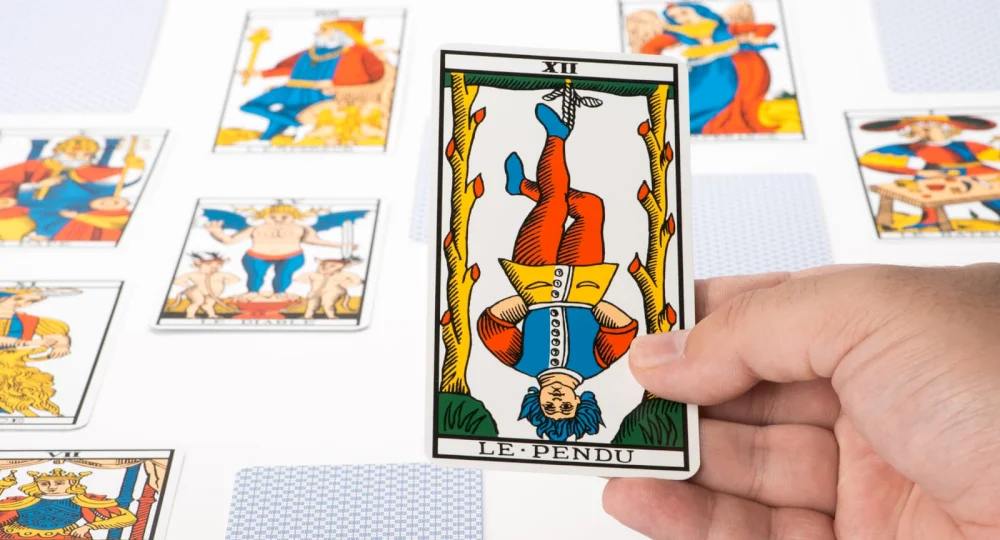
Tarot Meaning Hanged Man: Unlock Surrender & Transformation
April 18, 2025The Hanged Man card, a key component of any tarot deck, boasts a rich and layered history. Its journey through time reveals a captivating shift in interpretation, evolving from a symbol of harsh punishment to one of deep spiritual understanding. This evolution of the tarot meaning of the Hanged Man speaks volumes about how societal values and cultural shifts can reshape even the most powerful symbols.
The Surprising Evolution of The Hanged Man Through History
Early depictions of the card, arising in 15th-century Italian and French tarot decks, show a figure suspended upside down, frequently by one leg. Known as "Il Traditore" (The Traitor) or "L'Impicatto", the card’s meaning was closely associated with betrayal, shame, and public humiliation.
This imagery mirrored the grim realities of medieval justice. Hanging upside down by one ankle was a brutal punishment specifically for traitors. This historical context provides a stark contrast to the card's modern meaning.
The Hanged Man tarot card, numbered XII in the Major Arcana, historically symbolized betrayal and punishment. During the Middle Ages, being hanged upside down by one ankle was a form of execution reserved for traitors. This imagery directly reflects the treatment of criminals and figures like Benito Mussolini, who suffered such fates. The card originated in 15th-century Italian and French tarot decks, where it was called 'The Traitor' (Il Traditore or L'Impicatto). The depiction showed the figure hanging upside down, often by one leg, symbolizing shame and social humiliation.
Early interpretations emphasized negative connotations such as dishonesty, betrayal of trust, and the abandonment of plans. A 1750 manuscript from Bologna, for example, lists the card's meaning as betrayal. However, by the late 18th century, occultists like Antoine Court de Gébelin reinterpreted the card spiritually, associating it with prudence and self-sacrifice rather than punishment. This shift marked the card's transition from a symbol of criminality to one of enlightenment and transformation, influencing modern tarot interpretations worldwide.
From Punishment to Enlightenment: A Shift in Perspective
The meaning of the Hanged Man wasn't destined to remain solely negative. By the late 18th century, esoteric thinkers began to reimagine the card's symbolism. Figures like Antoine Court de Gébelin, a French occultist, moved away from the literal interpretation of punishment and focused instead on the spiritual implications of the inverted figure. This marked a crucial turning point.
The Birth of New Meanings
This reinterpretation saw the Hanged Man's meaning shift towards themes of prudence, self-sacrifice, and a willingness to embrace a different perspective. The inverted figure became a metaphor for surrendering to a higher power, pausing for reflection, and gaining wisdom through unconventional viewpoints. This new understanding laid the foundation for the card's meaning in modern tarot practice.
This transition is particularly striking. What was once a symbol of defeat and disgrace became a representation of spiritual growth and enlightenment. The Hanged Man's journey reminds us that even seemingly negative experiences can offer opportunities for transformation and deeper understanding. It reinforces the cyclical nature of life, death, and rebirth inherent in tarot symbolism. The Hanged Man invites us to embrace the unexpected and find the potential for growth in every situation, even those that seem challenging or reversed.
Decoding The Hanged Man's Symbolic Language
The Hanged Man, a captivating figure in the tarot, offers a rich and complex symbolic language. The figure's inverted posture immediately sets it apart, creating a sense of displacement and a break from the everyday. It speaks to a shift in perspective, an invitation to view the world from a completely new angle.
This altered viewpoint can be disorienting. However, it also holds the key to the card's inherent transformative power.
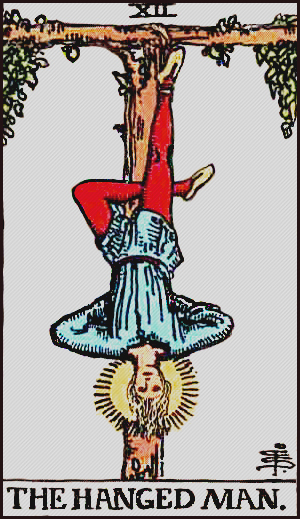
The Halo: From Punishment to Enlightenment
The halo, or nimbus, surrounding The Hanged Man's head is a pivotal symbol. It elevates the image from one of suffering to one of spiritual awakening. Often depicted as a radiant circle of light, the halo represents wisdom, insight, and a connection to something greater than ourselves.
Even amidst challenging circumstances, the halo suggests, there exists potential for deep understanding and spiritual growth. This symbolism reinforces the idea that the tarot meaning hanged man encompasses not just pause, but a significant shift in consciousness.
The Tau Cross and Spiritual Paradox
The Tau cross, frequently formed by the gallows from which The Hanged Man is suspended, is another key symbol. This ancient symbol represents spiritual paradox, the intersection of the earthly and the divine. It adds another layer to the tarot meaning hanged man, linking it to longstanding mystical traditions.
The Tau cross carries diverse meanings across various cultures. These include sacrifice, surrender, and the promise of renewal.
The Hanged Man in Divination and History
In tarot readings, The Hanged Man represents themes of pause, sacrifice, and gaining new perspectives. These are achieved through patience and reflection. A.E. Waite, the designer of the influential Rider-Waite tarot deck (published in 1910), famously described the card as depicting "life in suspension, but life and not death."
Waite's description underscores the card's association with wisdom, discernment, trials, and prophecy. He highlighted symbolic elements like the Tau cross and the halo to signify enlightenment and the connection between the divine and the universe. The card's upright meaning usually suggests surrender, introspection, and spiritual growth. Conversely, the reversed position often warns against selfishness and succumbing to external pressures.
Identifying The Hanged Man Across Decks
The artistic representation of The Hanged Man can vary across different tarot decks. However, the core symbolism remains consistent. By recognizing these core elements – the inverted figure, the halo, and the Tau cross – you can readily identify and interpret The Hanged Man regardless of the deck.
This visual literacy fosters a deeper understanding of the card's nuanced meanings, enriching your tarot practice and expanding your ability to interpret the tarot meaning hanged man in any spread.
Embracing The Upright Hanged Man's Wisdom
When the Hanged Man appears upright in a tarot spread, it signals a time for reflection and a shift in perspective. This isn't about feeling stuck, but rather an invitation to surrender to the present moment and trust the universe. This can be a challenging experience, but it often leads to powerful insights.
Recognizing The Hanged Man's Energy
The upright Hanged Man asks us to step outside our usual ways of thinking. This might manifest as a feeling of being at a crossroads. Perhaps you're facing a tough decision or navigating a period of uncertainty. A career change, a shift in a relationship, or a time of spiritual exploration can all evoke this energy. It's a call to accept the pause and allow new viewpoints to surface.
The Power of Productive Waiting
Many successful people point to periods of quiet reflection as the source of their greatest breakthroughs. This isn't procrastination, but a conscious choice to step back and allow creative solutions to emerge. The tarot meaning hanged man, upright, reminds us that sometimes, the most effective action is inaction. This can feel counterintuitive in our busy lives, but embracing stillness connects us with our intuition.
Productive Surrender vs. Procrastination
Understanding the difference between productive surrender and procrastination is key to harnessing the Hanged Man's wisdom. Productive surrender is a deliberate choice to pause and allow the universe to guide you. Procrastination, however, comes from fear or a lack of clarity. The Hanged Man encourages self-reflection. Are we avoiding something, or are we genuinely creating space for growth?
Practical Strategies for Embracing the Hanged Man
How can we practically apply the Hanged Man's wisdom? Here are a few strategies:
Meditation: Regular meditation cultivates calm and acceptance, making it easier to navigate uncertainty.
Journaling: Writing down your thoughts and feelings can reveal hidden insights and highlight areas where you might be resisting change.
Seeking Guidance: Talking to a trusted tarot reader can offer valuable support during times of transition. Advanced Tarot Online connects you with experienced readers.
The Hanged Man's Wisdom Across Life Areas
The Hanged Man's influence varies depending on which area of life it touches. The following table provides a breakdown of its interpretations across different life areas when appearing upright in a reading.
The Hanged Man's Meanings Across Life Areas
| Life Area | Interpretation | Key Themes | Advice |
|---|---|---|---|
| Career | Pause, reassess your career path, consider new options | Re-evaluation, Change | Embrace new opportunities, trust your intuition |
| Relationships | Let go of control, allow space for growth | Surrender, Trust | Communicate openly, embrace vulnerability |
| Spirituality | Connect with your inner wisdom, surrender to the divine | Intuition, Faith | Meditate, trust your inner guidance |
| Personal Growth | Embrace challenges as opportunities for transformation | Resilience, Acceptance | Seek support, practice self-compassion |
The table summarizes how the Hanged Man's energy plays out in different aspects of our lives, offering guidance on how to best navigate these energies. It emphasizes the importance of reflection, surrender, and trust in the process of personal growth.
By understanding the nuances of the upright Hanged Man, we can transform challenging pauses into opportunities for growth. The tarot meaning hanged man, upright, is not a symbol of defeat, but a catalyst for change and renewal. Embrace the pause.
When The Hanged Man Appears Reversed: Hidden Warnings
While the upright Hanged Man signifies willing surrender and a pause for reflection, its reversed counterpart often suggests resistance to this process. This resistance manifests in various ways, hindering personal growth and potentially leading to stagnation. Understanding these hidden warnings is crucial for navigating the complexities of this powerful card.
Resistance to Surrender and Clinging to Control
The reversed Hanged Man often reveals an unwillingness to relinquish control. This can manifest as clinging to outdated beliefs or refusing to adapt to necessary changes.
For example, in a career reading, it might appear when someone remains in a dead-end job despite knowing it's no longer fulfilling. This clinging can stem from fear, insecurity, or simply a reluctance to leave one's comfort zone. However, this resistance ultimately blocks the very transformation the Hanged Man, even in reverse, seeks to initiate.
False Martyrdom and Unnecessary Sacrifice
Another warning sign of the reversed Hanged Man is false martyrdom. This involves shouldering unnecessary burdens and making sacrifices without any real benefit. Often, this behavior stems from a need for sympathy or a desire to avoid personal responsibility.
This differs significantly from the upright Hanged Man's willing sacrifice, undertaken with awareness and purpose. The reversed Hanged Man's sacrifices are often driven by a need for validation or a fear of confronting deeper issues. Consequently, these actions can breed resentment and hinder true progress.
Avoiding Difficult Truths and Stalling Growth
The reversed Hanged Man can also indicate an avoidance of difficult truths. This might involve denying personal shortcomings or refusing to address challenging situations. In relationship readings, this might manifest as ignoring red flags or avoiding necessary conversations.
This avoidance ultimately stalls personal growth. It prevents individuals from confronting the challenges required for genuine transformation. Just like Madeline in the film Tarot, running from problems only leads to negative outcomes. Facing these truths, however uncomfortable, opens up possibilities for meaningful change and deeper self-understanding.
Identifying and Moving Through Reversed Hanged Man Energy
Recognizing when you're caught in the reversed Hanged Man's energy is the first step towards breaking free. This requires honest self-reflection. Consider these questions:
- Are you resisting necessary change due to fear?
- Are your sacrifices truly serving you, or are you seeking external validation?
- Are you avoiding difficult truths that need to be addressed?
By acknowledging these patterns, you can begin to shift your perspective and embrace the transformative power of the Hanged Man, even in its reversed state. Remember, even reversed, the Hanged Man offers an opportunity for growth, though perhaps a more challenging one. By working through the resistance, you can unlock the wisdom within the card’s challenging energy and move forward with greater awareness and purpose.
The Hanged Man's Cultural Legacy Beyond The Cards
The Hanged Man, a powerful symbol of surrender and altered perspectives, reaches far beyond tarot readings. This archetype has influenced creative expression for centuries, appearing in literature, visual arts, and film. Its enduring presence reflects the universal human experience of navigating transitions, uncertainty, and life's transformations.
Literary Echoes of Suspension and Insight
The Hanged Man's themes appear in literature, from classic works to modern novels. Characters grappling with difficult choices and seeking new understanding often mirror the card's call for introspection. Fyodor Dostoevsky's exploration of existential crises and moral dilemmas often reflects this. Contemporary authors also explore themes of suspended judgment and the search for meaning during periods of stagnation. These literary echoes demonstrate the Hanged Man's enduring message.
Visual Representations Across Art History
The Hanged Man's visual impact is striking. Its imagery has appeared in art from medieval iconography to contemporary exhibitions. The figure's inverted posture, often misinterpreted as negative, encourages viewers to reconsider their perspectives. The halo, frequently accompanying the figure, transforms the image from suffering to enlightenment, highlighting the card's transformative potential. These visual interpretations have solidified the Hanged Man's place as a symbol of introspection and spiritual awakening.
Cinematic Explorations of Sacrifice and Transformation
The Hanged Man's themes of sacrifice and transformation appear in both arthouse and popular films. The card's paradoxical wisdom suits cinematic narratives exploring surrender, acceptance, and the challenging journey of self-discovery. Filmmakers use the Hanged Man's symbolism to represent characters at crucial moments, emphasizing the need to let go to move forward.
The Hanged Man in Contemporary Culture
In recent decades, the Hanged Man has become a significant cultural and artistic symbol beyond divination. The symbolism — life in suspension, critical crossroads, and transformation — resonates globally, reflecting human experiences of uncertainty and change.
The Timeless Resonance of Paradoxical Wisdom
The Hanged Man's continued relevance across creative mediums highlights the universal nature of its paradoxical wisdom. Its message transcends familiarity with tarot, offering insight into human experiences of transition and uncertainty. This broader context enriches our understanding of the tarot meaning of the hanged man, revealing its psychological and spiritual significance. Whether encountered on a tarot card, in a novel, or on film, the Hanged Man encourages us to embrace the potential for growth during life's periods of suspension and change.
Integrating The Hanged Man's Wisdom Into Daily Life
The Hanged Man isn't just a card you draw in a reading; it's a profound archetype offering guidance for everyday life. This section explores practical ways to embody the tarot meaning of The Hanged Man, transforming this figure from an occasional visitor in your readings into a constant companion on your personal journey. This involves shifting our perspective on waiting and embracing the power of surrender.
Cultivating Comfortable Surrender Through Meditation
One path to integrating The Hanged Man's wisdom is through meditation. Practicing stillness creates space for insights to surface. It's not about forcing a blank mind, but about fostering receptive awareness. Like The Hanged Man's suspended state, meditation allows us to detach from our usual thoughts and access deeper understanding.
Journaling Prompts For Unveiling Resistance
Journaling offers another way to explore The Hanged Man's energy. Focused prompts can reveal where we resist necessary pauses or cling to control. Questions like "Where in my life am I feeling stuck?" or "What am I afraid to let go of?" can illuminate hidden obstacles. This self-reflection can uncover areas where surrender, a core principle of The Hanged Man, would be beneficial. Acknowledging these areas allows us to release resistance and embrace transformation through stillness.
Decision-Making Through Strategic Waiting
The Hanged Man teaches us the value of strategic waiting. This isn't procrastination, but recognizing divine timing. Sometimes, the best action is inaction. This concept is crucial to understanding the tarot meaning of The Hanged Man. Just as The Hanged Man hangs in suspension, there are times in life when pausing and reassessing is essential. This requires discernment – are we genuinely waiting for clarity, or avoiding a difficult decision? Developing this discernment transforms waiting from passive to active growth.
Recognizing Divine Timing vs. Avoidance
Distinguishing between divine timing and avoidance is key to integrating The Hanged Man's lessons. Divine timing suggests circumstances aren't yet aligned for action, while avoidance stems from fear or resistance. This relates directly to the difference between the upright and reversed meanings of The Hanged Man. It demands honesty and self-awareness. Are we truly waiting for the right moment, or using "waiting" as a shield? Spiritual practice emphasizes the importance of inner listening to differentiate these states.
Creating Sacred Space for Insights
To fully embrace The Hanged Man’s wisdom, create sacred space for insights to emerge. This could involve dedicating time for quiet reflection, or creating a dedicated area for meditation and journaling. The goal is to cultivate an environment that supports inner listening and contemplation, similar to how The Hanged Man’s suspended state allows for a different perspective. Prioritizing this inner work attunes us to intuition and guidance, leading to more aligned actions and decisions. Integrating The Hanged Man translates reflection into meaningful action.
To better understand the varying interpretations of The Hanged Man, the following table compares its depiction across several popular tarot decks.
Comparing The Hanged Man Across Popular Tarot Decks: This comparison table highlights how different major tarot decks depict and interpret The Hanged Man, including key symbolic differences.
| Deck Name | Visual Elements | Symbolic Emphasis | Unique Interpretation |
|---|---|---|---|
| Rider-Waite-Smith | Figure hanging by one foot, halo around head | Surrender, suspension, new perspectives | Emphasizes the temporary nature of the suspension and the enlightenment gained. |
| Thoth Tarot | Illuminated figure hanging from a T-shaped cross | Sacrifice, enlightenment, the Great Work of alchemy | Connects the Hanged Man to the process of spiritual transformation and self-perfection. |
| Marseilles Tarot | Simpler depiction of a hanging figure | Pause, reflection, reevaluation | Focuses on the period of waiting and introspection, without explicitly highlighting spiritual aspects. |
| Wild Unknown Tarot | Hanging bat | Letting go, releasing control, trusting the unknown | Emphasizes the surrender to natural processes and the embrace of uncertainty. |
This table reveals how the core symbolism of The Hanged Man — surrender, new perspectives, and a period of waiting — is interpreted with different nuances across various tarot traditions. Each deck offers a unique lens through which to explore this archetype's potent energy.
The Paradoxical Path Forward
The Hanged Man, suspended between two realms, embodies a core paradox: progress through stillness. This seemingly contradictory idea forms the foundation of the card's meaning. To advance, we sometimes need to surrender, embracing a period of introspection and waiting.
This counterintuitive approach unlocks the transformative power inherent in the tarot meaning hanged man. It serves as a reminder that true freedom often emerges from accepting what lies beyond our control.
From Punishment to Enlightenment: Mirroring Our Own Evolution
The Hanged Man's transformation, from a symbol of medieval penalty to one of spiritual guidance, mirrors our personal development. We learn and mature through trials, converting obstacles into opportunities. Just as the card's interpretation has shifted over time, we too should constantly reassess our beliefs and perspectives.
The Hanged Man encourages us to find meaning in life’s pauses, similar to Madeline’s experience in the film Tarot. She was advised to surrender, but instead chose to flee.
Reframing Waiting, Sacrifice, and Perspective
The Hanged Man prompts us to rethink our relationship with waiting, sacrifice, and shifts in perspective. Waiting ceases to be a time of stagnation and becomes fertile ground for personal growth.
Sacrifice evolves from a burden to a willing offering, unveiling new possibilities. Perspective shifts, initially unsettling, transform into portals to deeper understanding.
This reframing is key to understanding the tarot meaning hanged man. It allows us to value the card's paradoxical wisdom and integrate it into our lives.
This journey takes courage. It necessitates a willingness to embrace the unknown and have faith in the process of transformation. By internalizing these lessons, we move beyond simply interpreting the Hanged Man in a reading to embodying its wisdom in our everyday existence. We begin to see life’s challenges not as obstacles, but as chances for profound growth and deeper meaning. Ready to delve deeper and explore your personal journey with the Hanged Man? Explore your potential with Advanced Tarot Online.

